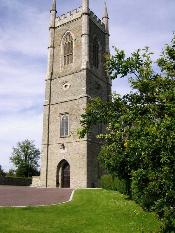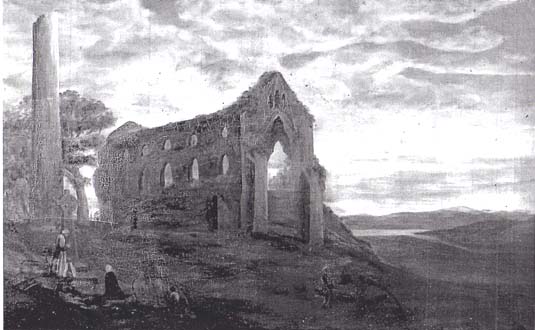Downpatrick
is the county town of Down, evidence of human habitation from the stone
In 432 St Patrick landed at the mouth of the Slaney river in Strangford Lough, Patrick built his first church at Saul and began his mission in Ireland, when he died in 461 he was buried at Downpatrick. There was much activity in and around Strangford Lough during the Viking period in 926 Muirchertach defeated the Vikings in a battle on Strangford. The Vikings don't seem to have established any permanent settlements in the area, possibly because they did not have total command of the sea. The Ulaid fleet were said to have commanded the Irish sea and Hebrides during the 4th and 5th centuries, so in all possibility when the Vikings appeared in the 9th century, the Ulaid's naval capability still existed. legend has it that the Vikings sailed round the Mound of Down when they came to Down. In Gaelic times the area was ruled by the MacDunleavy clan, who probably had their headquarters on the Mound of Down, in 1137 St Malachy founded an Augustinian Friary on an island near Downpatrick. With the Norman invasion John de Courcy a Norman knight from Somerset in England invaded Downpatrick in 1177 he was met by Rory MacDunleavy who despite commanding a force of 10,000 men against de Courcy's 700 was defeated, the Norman's cavalry, armour and crossbows made them a vastly superior force. After the battle de Courcy built a
motte and Baile castle on the Mound of Down, in 1180 he installed monks
more di St Patricks cathedral is said to be the resting place of the remains not only of St Patrick but St Brigid who died in 523 and was buried in her church in Kildare, also St Columcille who died in 594 on the Scottish island of Iona, he too was buried in his church there. The bones of the saints lay undisturbed for three century's, till the Vikings began to plunder both Scotland and Ireland, Kildare cathedral was burned, it was decided that Down would be a safe repository for the relics. Columcille's remains were first brought to Down in 824, his remains appear to have made several journeys across the Irish sea before finally being deposited in Downpatrick in 877. Some three hundred years had elapsed since the last burial and their exact position was unknown, De Courcy anxious to make political capital ordered Bishop Malachy to locate them, after a suitable time in prayer they were produced. De Courcy, and the bishop sent messengers to the Pope Urban III for permission to bury them in a more suitable location inside the church. Papal permission was granted and the Papal legate Cardinal Vivian, already well known to both de Courcy and Malachy, was dispatched to County Down to preside at the ceremony. On the 9th of June1196, on the Feast day of St Columcille, in the presence of fifteen bishops, from all over Ireland and a large number of Clergy, the relics of St Patrick Brigid and Columcille were buried in one tomb with great solemnity. The exact location of this burial is also lost, a large stone in the graveyard was placed there in recent times. After this period the Normans slowly began to integrate with the Irish, to the extent that they largely lost their Norman identity as they adopted Irish customs and traditions. Eventually County Down and indeed much of Ulster was under the control of the O'Neill Clan. In 1500 England only held and area around Dublin known as the 'pale'. Spasmodic attempts were made to plant Ulster with English settlers, in 1569 Sir Thomas Smith was granted some O'Neill land, Smith's plantation was unsuccessful. It was decided in England to pursued the plantation policy with more ferocity. Employed in this task were English nobles such as the Earl's of Essex, the Earl of Sussex, Sir George Carew, Lord Mountjoy and probably most notoriously Sir Arthur Chichester, the effects of the scorched earth policy employed by all the aforementioned left thousands dead initially by the sword and those who survived perished later from starvation. The Irish lords rose in rebellion, they had many initial successes but were eventually defeated in 1601 at the Battle of Kinsale. In the treaty of Mellifont in 1603, O'Neill surrendered and gave up his Irish title, O'Neill, and took the title Earl of Tyrone. He was allowed to retain most of the lands that had been granted to Conn O'Neill in 1542. Rory O'Donnell, younger brother of Red Hugh, became Earl of Tyrconnell on the same terms. The two earls traveled to London, where the newly crowned king, James I, confirmed the Treaty of Mellifont. The royal courts are notorious for intrigues and no doubt James I was surrounded by nobles and officials casting a greedy eye on Ireland. Rumors were spread that O'Neill and O'Donnell were planning another rebellion, the earls were summoned to London for questioning. Fearing for their safety, in light of the execution of Silken Thomas, the earls decided that the best course would be to leave the country and, in 1607, they sailed from Rathmullen on Lough Swilly for the mainland of Europe. Almost immediately England decreed their land forfeit and seized it for the crown. After the 'Flight of the Earls' 1n 1607 much of County Down was granted to English and Scottish settlers, evidence of this can be seen in some of the street names, Scots Street, English Street and Irish Street In the United Irishmen's Rebellion of 1798 one of the local leaders Thomas Russell was hanged at Downpatrick goal is now the county museum. Much of Downpatrick's trade was once carried by water, prior to the 1950's when a tidal barrier was built across the Quoile to control flooding, the tidal effects of Strangford Lough could be seen in the town, to the east of the town close to the Strangford road can be seen a steamboat quay built in the 1800's, although no doubt the site had been in use for many centuries prior to this. The railway came to Downpatrick prior to 1858 giving the town an economic boost, and the poorer population of the town an opportunity to travel, the line was extended to Newcastle in 1869. Today the railway station and a section of the line are under the care of dedicated volunteers who run steam trains during the summer months. (More Inf)
|
|||||||||||
|
|



 sposed
to his political and religious agenda in Inch Abbey. Because of rivalry
between Norman knights a further battle took place near the town in 1203
when Hugh de Lacy took control of County Down from John de Courcy. This
situation was to be reversed shortly after when
sposed
to his political and religious agenda in Inch Abbey. Because of rivalry
between Norman knights a further battle took place near the town in 1203
when Hugh de Lacy took control of County Down from John de Courcy. This
situation was to be reversed shortly after when